Application of Statistical Methods in Business Decision-Making
VerifiedAdded on 2020/06/04
|18
|3321
|200
AI Summary
The report investigates how organizations utilize statistical techniques, particularly focusing on the Economic Order Quantity (EOQ), to make informed decisions about inventory management. By examining case studies and theoretical models, students assess the impact of EOQ on minimizing costs and optimizing resource allocation. The analysis includes evaluating different types of charts and data interpretations used in business statistics, providing insights into effective decision-making processes.
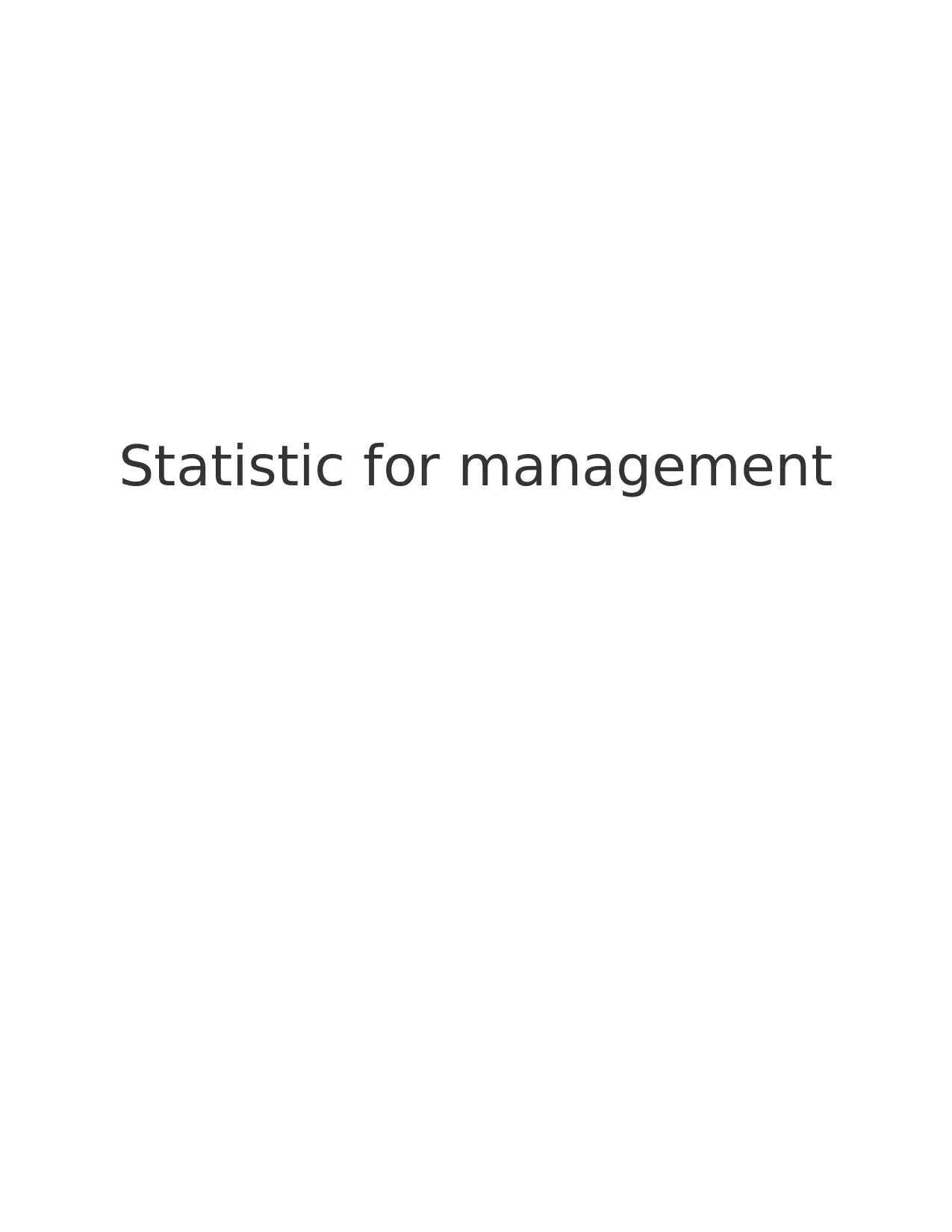
Statistic for management
Paraphrase This Document
Need a fresh take? Get an instant paraphrase of this document with our AI Paraphraser
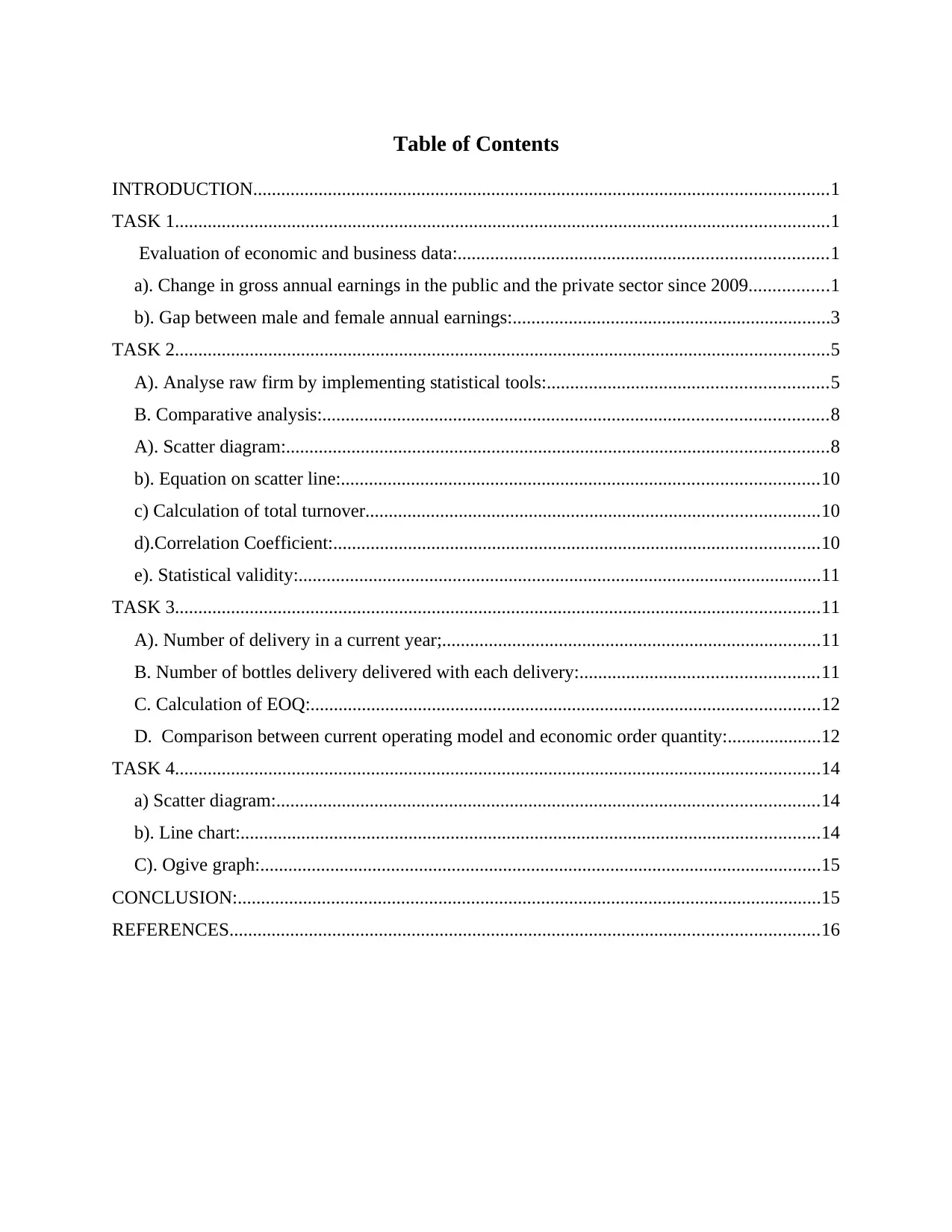
Table of Contents
INTRODUCTION...........................................................................................................................1
TASK 1............................................................................................................................................1
Evaluation of economic and business data:...............................................................................1
a). Change in gross annual earnings in the public and the private sector since 2009.................1
b). Gap between male and female annual earnings:....................................................................3
TASK 2............................................................................................................................................5
A). Analyse raw firm by implementing statistical tools:............................................................5
B. Comparative analysis:............................................................................................................8
A). Scatter diagram:....................................................................................................................8
b). Equation on scatter line:......................................................................................................10
c) Calculation of total turnover.................................................................................................10
d).Correlation Coefficient:........................................................................................................10
e). Statistical validity:................................................................................................................11
TASK 3..........................................................................................................................................11
A). Number of delivery in a current year;.................................................................................11
B. Number of bottles delivery delivered with each delivery:...................................................11
C. Calculation of EOQ:.............................................................................................................12
D. Comparison between current operating model and economic order quantity:....................12
TASK 4..........................................................................................................................................14
a) Scatter diagram:....................................................................................................................14
b). Line chart:............................................................................................................................14
C). Ogive graph:........................................................................................................................15
CONCLUSION:.............................................................................................................................15
REFERENCES..............................................................................................................................16
INTRODUCTION...........................................................................................................................1
TASK 1............................................................................................................................................1
Evaluation of economic and business data:...............................................................................1
a). Change in gross annual earnings in the public and the private sector since 2009.................1
b). Gap between male and female annual earnings:....................................................................3
TASK 2............................................................................................................................................5
A). Analyse raw firm by implementing statistical tools:............................................................5
B. Comparative analysis:............................................................................................................8
A). Scatter diagram:....................................................................................................................8
b). Equation on scatter line:......................................................................................................10
c) Calculation of total turnover.................................................................................................10
d).Correlation Coefficient:........................................................................................................10
e). Statistical validity:................................................................................................................11
TASK 3..........................................................................................................................................11
A). Number of delivery in a current year;.................................................................................11
B. Number of bottles delivery delivered with each delivery:...................................................11
C. Calculation of EOQ:.............................................................................................................12
D. Comparison between current operating model and economic order quantity:....................12
TASK 4..........................................................................................................................................14
a) Scatter diagram:....................................................................................................................14
b). Line chart:............................................................................................................................14
C). Ogive graph:........................................................................................................................15
CONCLUSION:.............................................................................................................................15
REFERENCES..............................................................................................................................16

You're viewing a preview
Unlock full access by subscribing today!
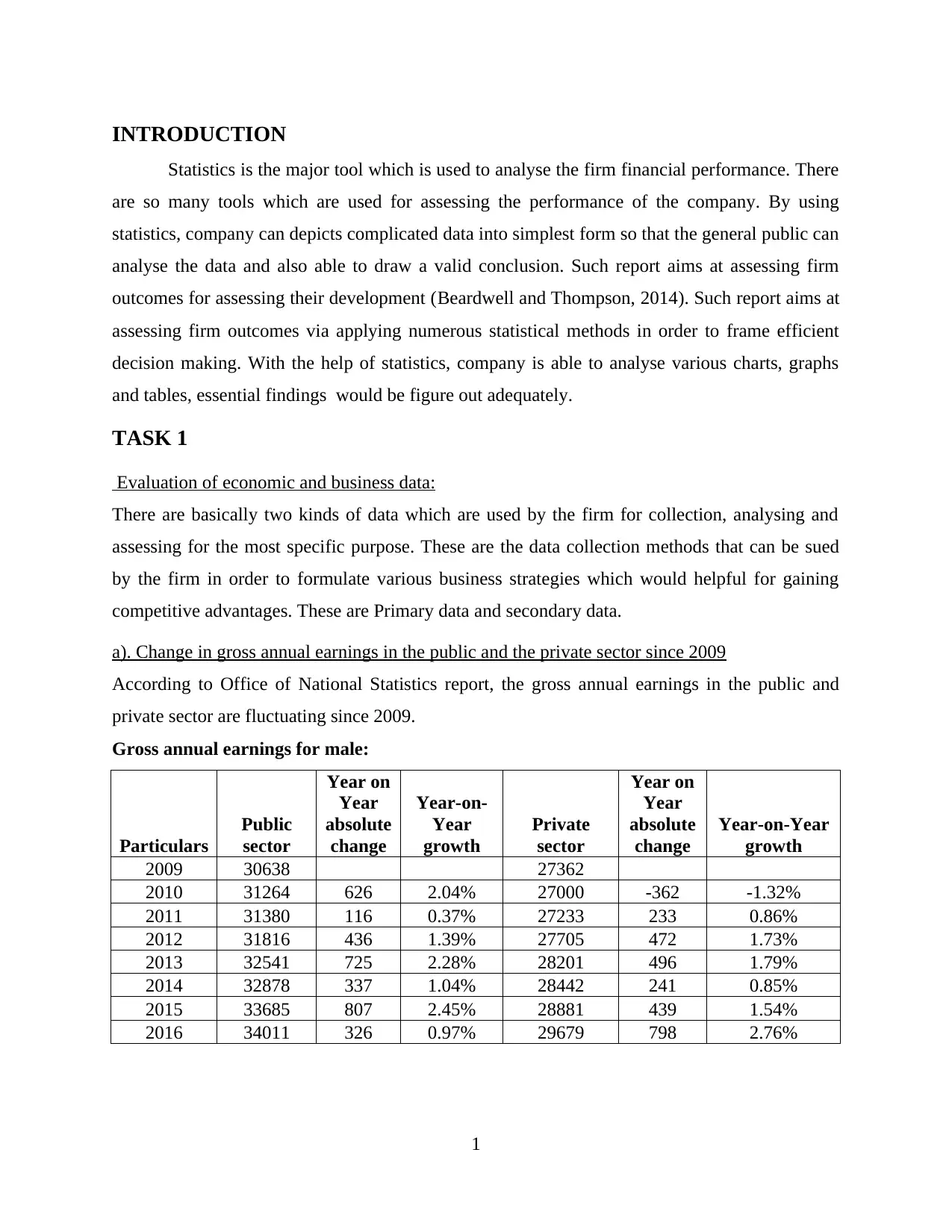
INTRODUCTION
Statistics is the major tool which is used to analyse the firm financial performance. There
are so many tools which are used for assessing the performance of the company. By using
statistics, company can depicts complicated data into simplest form so that the general public can
analyse the data and also able to draw a valid conclusion. Such report aims at assessing firm
outcomes for assessing their development (Beardwell and Thompson, 2014). Such report aims at
assessing firm outcomes via applying numerous statistical methods in order to frame efficient
decision making. With the help of statistics, company is able to analyse various charts, graphs
and tables, essential findings would be figure out adequately.
TASK 1
Evaluation of economic and business data:
There are basically two kinds of data which are used by the firm for collection, analysing and
assessing for the most specific purpose. These are the data collection methods that can be sued
by the firm in order to formulate various business strategies which would helpful for gaining
competitive advantages. These are Primary data and secondary data.
a). Change in gross annual earnings in the public and the private sector since 2009
According to Office of National Statistics report, the gross annual earnings in the public and
private sector are fluctuating since 2009.
Gross annual earnings for male:
Particulars
Public
sector
Year on
Year
absolute
change
Year-on-
Year
growth
Private
sector
Year on
Year
absolute
change
Year-on-Year
growth
2009 30638 27362
2010 31264 626 2.04% 27000 -362 -1.32%
2011 31380 116 0.37% 27233 233 0.86%
2012 31816 436 1.39% 27705 472 1.73%
2013 32541 725 2.28% 28201 496 1.79%
2014 32878 337 1.04% 28442 241 0.85%
2015 33685 807 2.45% 28881 439 1.54%
2016 34011 326 0.97% 29679 798 2.76%
1
Statistics is the major tool which is used to analyse the firm financial performance. There
are so many tools which are used for assessing the performance of the company. By using
statistics, company can depicts complicated data into simplest form so that the general public can
analyse the data and also able to draw a valid conclusion. Such report aims at assessing firm
outcomes for assessing their development (Beardwell and Thompson, 2014). Such report aims at
assessing firm outcomes via applying numerous statistical methods in order to frame efficient
decision making. With the help of statistics, company is able to analyse various charts, graphs
and tables, essential findings would be figure out adequately.
TASK 1
Evaluation of economic and business data:
There are basically two kinds of data which are used by the firm for collection, analysing and
assessing for the most specific purpose. These are the data collection methods that can be sued
by the firm in order to formulate various business strategies which would helpful for gaining
competitive advantages. These are Primary data and secondary data.
a). Change in gross annual earnings in the public and the private sector since 2009
According to Office of National Statistics report, the gross annual earnings in the public and
private sector are fluctuating since 2009.
Gross annual earnings for male:
Particulars
Public
sector
Year on
Year
absolute
change
Year-on-
Year
growth
Private
sector
Year on
Year
absolute
change
Year-on-Year
growth
2009 30638 27362
2010 31264 626 2.04% 27000 -362 -1.32%
2011 31380 116 0.37% 27233 233 0.86%
2012 31816 436 1.39% 27705 472 1.73%
2013 32541 725 2.28% 28201 496 1.79%
2014 32878 337 1.04% 28442 241 0.85%
2015 33685 807 2.45% 28881 439 1.54%
2016 34011 326 0.97% 29679 798 2.76%
1
Paraphrase This Document
Need a fresh take? Get an instant paraphrase of this document with our AI Paraphraser
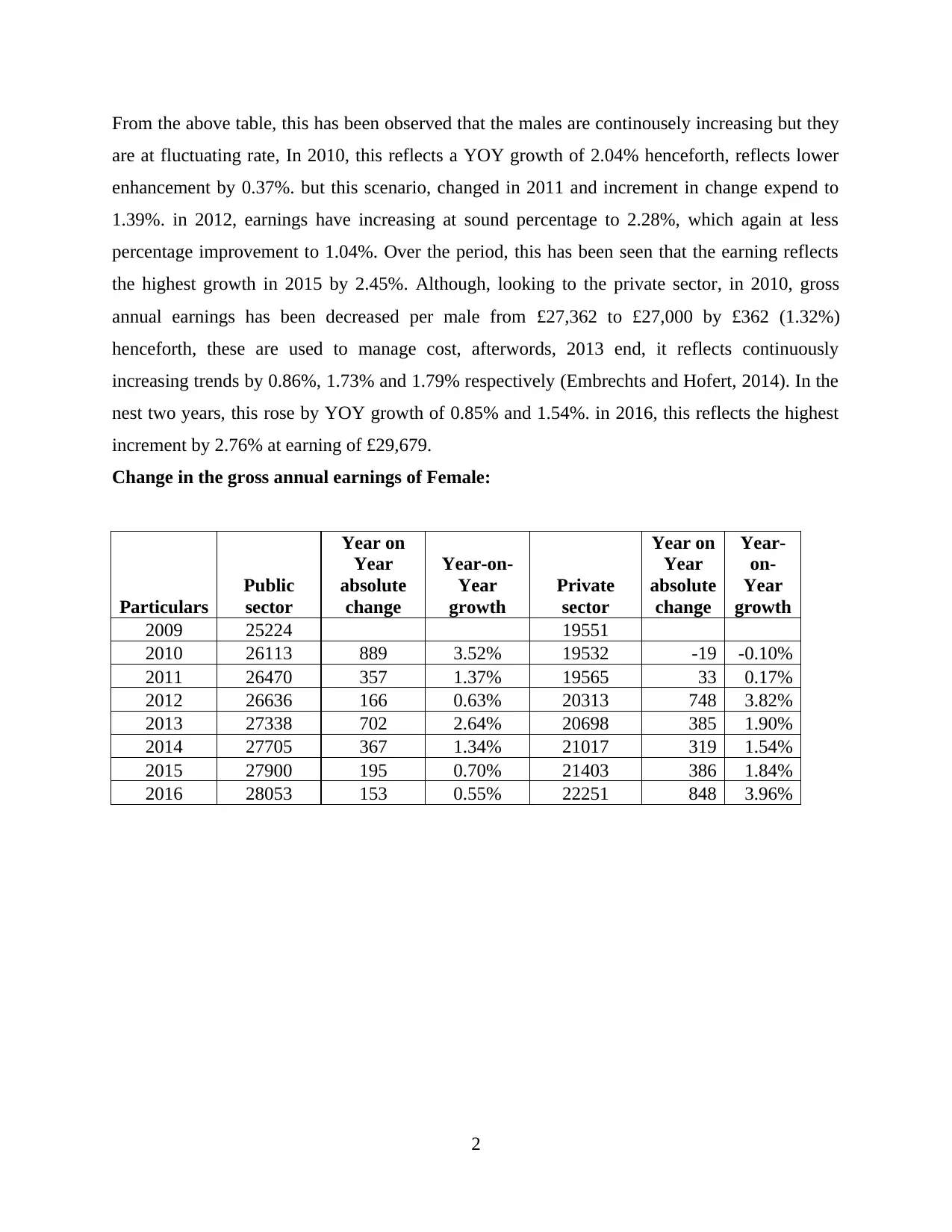
From the above table, this has been observed that the males are continousely increasing but they
are at fluctuating rate, In 2010, this reflects a YOY growth of 2.04% henceforth, reflects lower
enhancement by 0.37%. but this scenario, changed in 2011 and increment in change expend to
1.39%. in 2012, earnings have increasing at sound percentage to 2.28%, which again at less
percentage improvement to 1.04%. Over the period, this has been seen that the earning reflects
the highest growth in 2015 by 2.45%. Although, looking to the private sector, in 2010, gross
annual earnings has been decreased per male from £27,362 to £27,000 by £362 (1.32%)
henceforth, these are used to manage cost, afterwords, 2013 end, it reflects continuously
increasing trends by 0.86%, 1.73% and 1.79% respectively (Embrechts and Hofert, 2014). In the
nest two years, this rose by YOY growth of 0.85% and 1.54%. in 2016, this reflects the highest
increment by 2.76% at earning of £29,679.
Change in the gross annual earnings of Female:
Particulars
Public
sector
Year on
Year
absolute
change
Year-on-
Year
growth
Private
sector
Year on
Year
absolute
change
Year-
on-
Year
growth
2009 25224 19551
2010 26113 889 3.52% 19532 -19 -0.10%
2011 26470 357 1.37% 19565 33 0.17%
2012 26636 166 0.63% 20313 748 3.82%
2013 27338 702 2.64% 20698 385 1.90%
2014 27705 367 1.34% 21017 319 1.54%
2015 27900 195 0.70% 21403 386 1.84%
2016 28053 153 0.55% 22251 848 3.96%
2
are at fluctuating rate, In 2010, this reflects a YOY growth of 2.04% henceforth, reflects lower
enhancement by 0.37%. but this scenario, changed in 2011 and increment in change expend to
1.39%. in 2012, earnings have increasing at sound percentage to 2.28%, which again at less
percentage improvement to 1.04%. Over the period, this has been seen that the earning reflects
the highest growth in 2015 by 2.45%. Although, looking to the private sector, in 2010, gross
annual earnings has been decreased per male from £27,362 to £27,000 by £362 (1.32%)
henceforth, these are used to manage cost, afterwords, 2013 end, it reflects continuously
increasing trends by 0.86%, 1.73% and 1.79% respectively (Embrechts and Hofert, 2014). In the
nest two years, this rose by YOY growth of 0.85% and 1.54%. in 2016, this reflects the highest
increment by 2.76% at earning of £29,679.
Change in the gross annual earnings of Female:
Particulars
Public
sector
Year on
Year
absolute
change
Year-on-
Year
growth
Private
sector
Year on
Year
absolute
change
Year-
on-
Year
growth
2009 25224 19551
2010 26113 889 3.52% 19532 -19 -0.10%
2011 26470 357 1.37% 19565 33 0.17%
2012 26636 166 0.63% 20313 748 3.82%
2013 27338 702 2.64% 20698 385 1.90%
2014 27705 367 1.34% 21017 319 1.54%
2015 27900 195 0.70% 21403 386 1.84%
2016 28053 153 0.55% 22251 848 3.96%
2

As per the change in the gross annual earnings of female, it has observed that in public sector,
there are various opportunities which are easy to locate from whole female employees. In 2010,
females in the public industry reflects a vast emergence of 3.52% while, in private sector, this
came down to 0.10%. there after, public sector reflects an increasing trends but slow rate by
1.37% and 0.63%, although, private sector reflects an lucrative development by 3.82% in 2012.
From 2014, female employees' in the public sector were getting great salary, whereas YOY
growth is lower in 2014,2015 and 2016 which were 1.34%, 0.70% and 3.96% respectively (Guan
and Zhao, 2012).
b). Gap between male and female annual earnings:
Public sector Male Female Gap
2009 30638 25224 5414
2010 31264 26113 5151
2011 31380 26470 4910
2012 31816 26636 5180
2013 32541 27338 5203
2014 32878 27705 5173
2015 33685 27900 5785
2016 34011 28053 5958
3
there are various opportunities which are easy to locate from whole female employees. In 2010,
females in the public industry reflects a vast emergence of 3.52% while, in private sector, this
came down to 0.10%. there after, public sector reflects an increasing trends but slow rate by
1.37% and 0.63%, although, private sector reflects an lucrative development by 3.82% in 2012.
From 2014, female employees' in the public sector were getting great salary, whereas YOY
growth is lower in 2014,2015 and 2016 which were 1.34%, 0.70% and 3.96% respectively (Guan
and Zhao, 2012).
b). Gap between male and female annual earnings:
Public sector Male Female Gap
2009 30638 25224 5414
2010 31264 26113 5151
2011 31380 26470 4910
2012 31816 26636 5180
2013 32541 27338 5203
2014 32878 27705 5173
2015 33685 27900 5785
2016 34011 28053 5958
3
You're viewing a preview
Unlock full access by subscribing today!
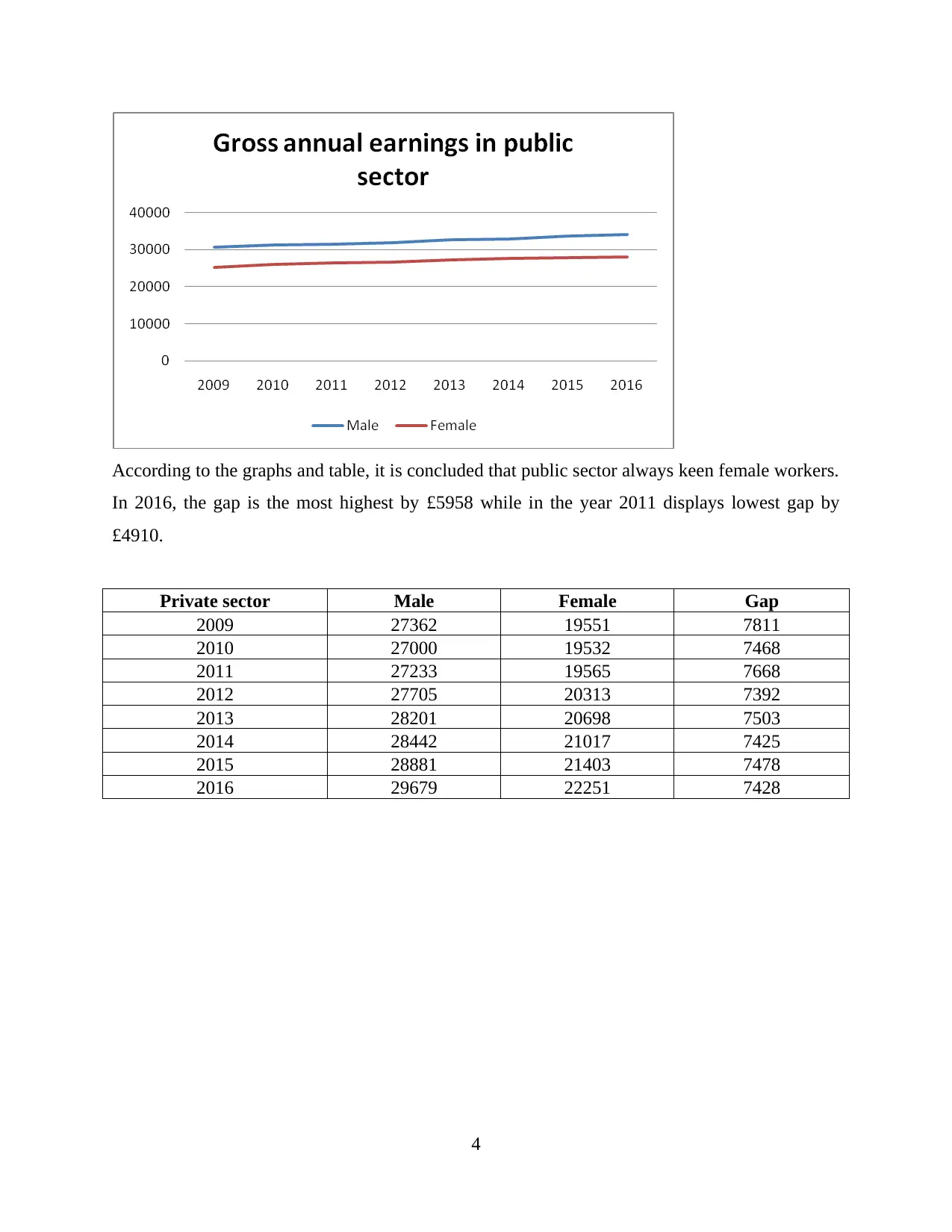
According to the graphs and table, it is concluded that public sector always keen female workers.
In 2016, the gap is the most highest by £5958 while in the year 2011 displays lowest gap by
£4910.
Private sector Male Female Gap
2009 27362 19551 7811
2010 27000 19532 7468
2011 27233 19565 7668
2012 27705 20313 7392
2013 28201 20698 7503
2014 28442 21017 7425
2015 28881 21403 7478
2016 29679 22251 7428
4
In 2016, the gap is the most highest by £5958 while in the year 2011 displays lowest gap by
£4910.
Private sector Male Female Gap
2009 27362 19551 7811
2010 27000 19532 7468
2011 27233 19565 7668
2012 27705 20313 7392
2013 28201 20698 7503
2014 28442 21017 7425
2015 28881 21403 7478
2016 29679 22251 7428
4
Paraphrase This Document
Need a fresh take? Get an instant paraphrase of this document with our AI Paraphraser

In private sector, the gap between annual earnings of the male and female employee is
comparatively greater to public sector workers. The largest gap is determined in 2009 by £7811,
on the other hand, this is the lowest in 2012 by £7392. however, male are getting attractive
earnings in public sector. But, high gap is recorded in the private industries. As, they paid female
workers with lower salary (Haimes, 2015).
TASK 2
A). Analyse raw firm by implementing statistical tools:
Earnings of different employees:
Hourly earnings (CI) F Relative frequency Cumulative frequency Cumulative relative frequency
0-10 8 8% 8 8%
10-20 46 46% 54 54%
20-30 26 26% 80 80%
30-40 14 14% 94 94%
40-50 6 6% 100 100%
100
5
comparatively greater to public sector workers. The largest gap is determined in 2009 by £7811,
on the other hand, this is the lowest in 2012 by £7392. however, male are getting attractive
earnings in public sector. But, high gap is recorded in the private industries. As, they paid female
workers with lower salary (Haimes, 2015).
TASK 2
A). Analyse raw firm by implementing statistical tools:
Earnings of different employees:
Hourly earnings (CI) F Relative frequency Cumulative frequency Cumulative relative frequency
0-10 8 8% 8 8%
10-20 46 46% 54 54%
20-30 26 26% 80 80%
30-40 14 14% 94 94%
40-50 6 6% 100 100%
100
5
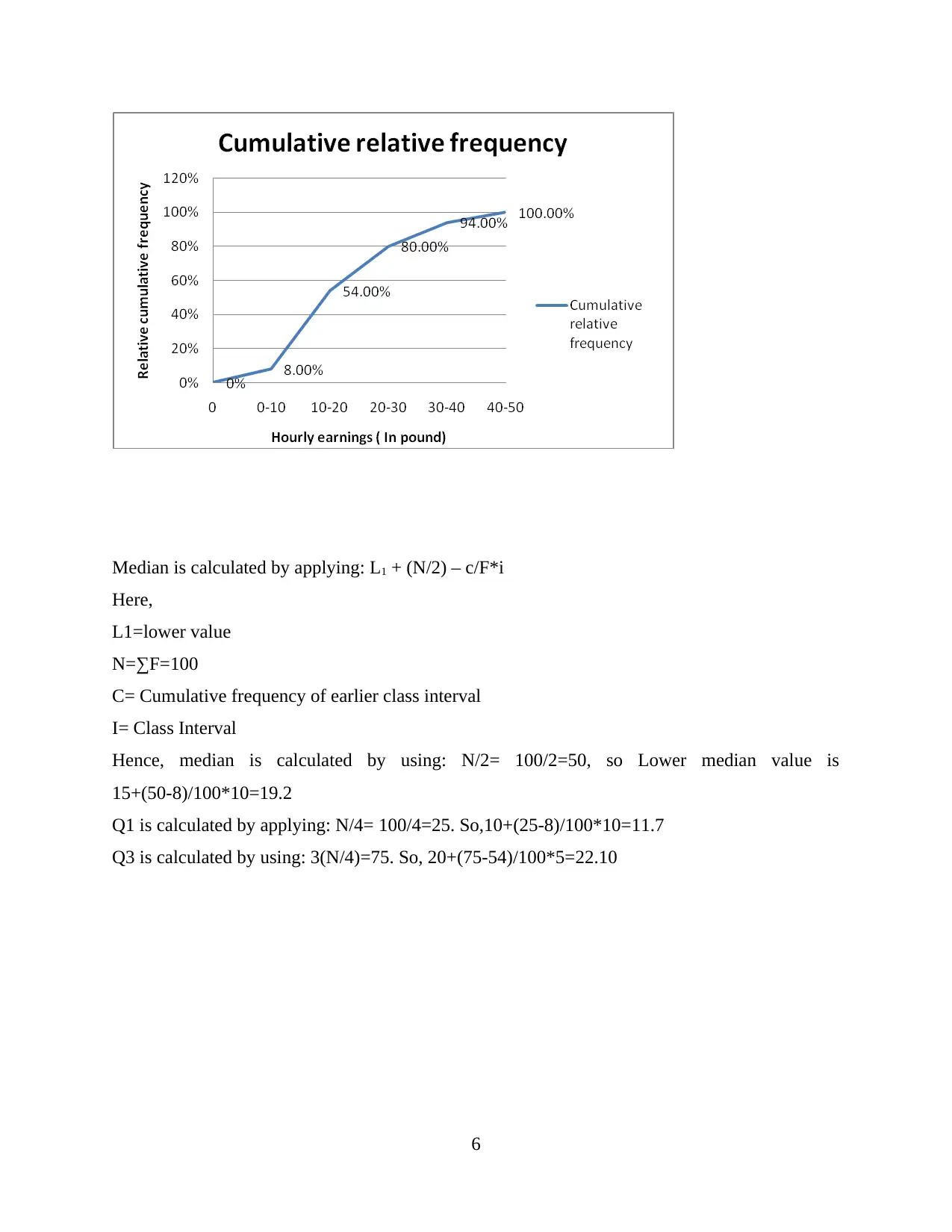
Median is calculated by applying: L1 + (N/2) – c/F*i
Here,
L1=lower value
N=∑F=100
C= Cumulative frequency of earlier class interval
I= Class Interval
Hence, median is calculated by using: N/2= 100/2=50, so Lower median value is
15+(50-8)/100*10=19.2
Q1 is calculated by applying: N/4= 100/4=25. So,10+(25-8)/100*10=11.7
Q3 is calculated by using: 3(N/4)=75. So, 20+(75-54)/100*5=22.10
6
Here,
L1=lower value
N=∑F=100
C= Cumulative frequency of earlier class interval
I= Class Interval
Hence, median is calculated by using: N/2= 100/2=50, so Lower median value is
15+(50-8)/100*10=19.2
Q1 is calculated by applying: N/4= 100/4=25. So,10+(25-8)/100*10=11.7
Q3 is calculated by using: 3(N/4)=75. So, 20+(75-54)/100*5=22.10
6
You're viewing a preview
Unlock full access by subscribing today!
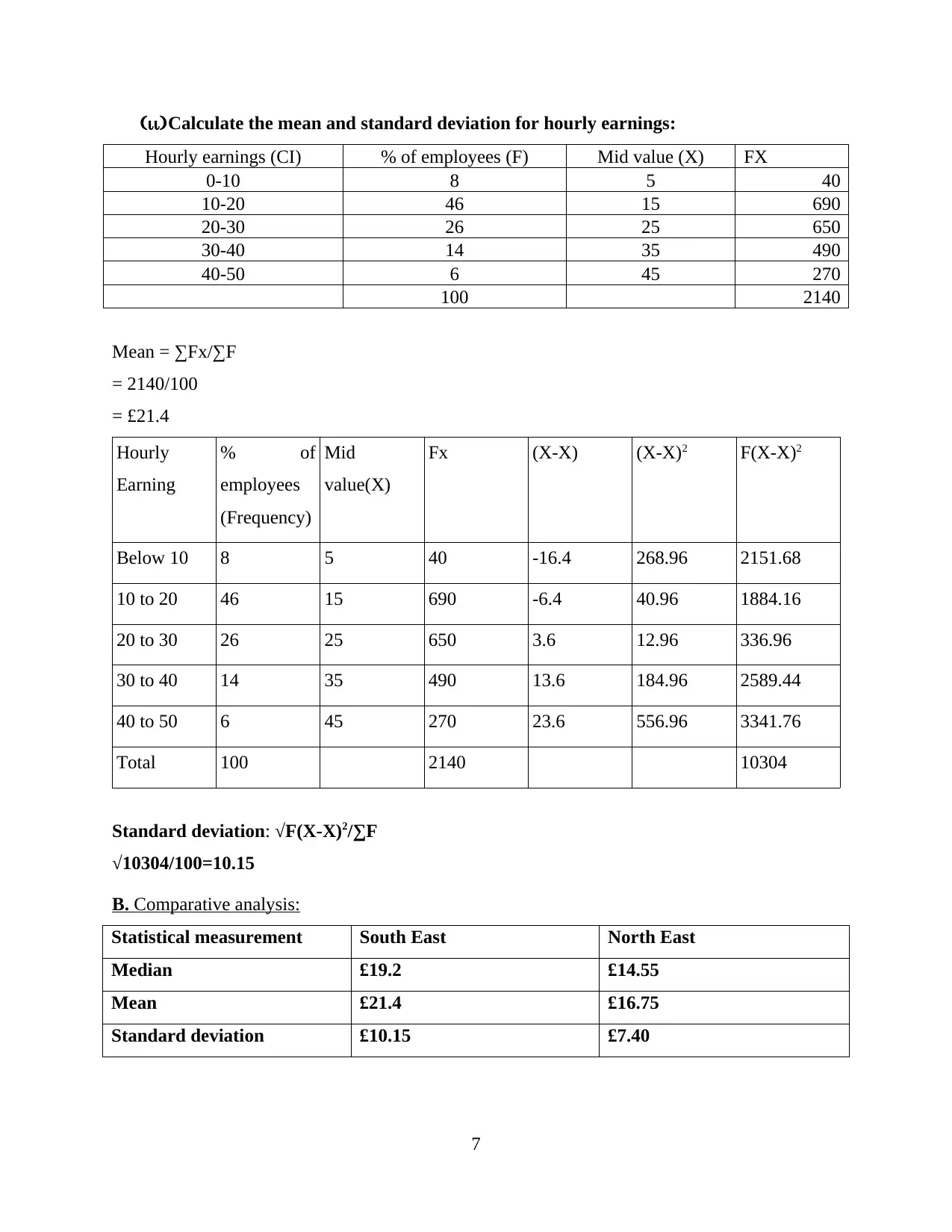
(ii)Calculate the mean and standard deviation for hourly earnings:
Hourly earnings (CI) % of employees (F) Mid value (X) FX
0-10 8 5 40
10-20 46 15 690
20-30 26 25 650
30-40 14 35 490
40-50 6 45 270
100 2140
Mean = ∑Fx/∑F
= 2140/100
= £21.4
Hourly
Earning
% of
employees
(Frequency)
Mid
value(X)
Fx (X-X) (X-X)2 F(X-X)2
Below 10 8 5 40 -16.4 268.96 2151.68
10 to 20 46 15 690 -6.4 40.96 1884.16
20 to 30 26 25 650 3.6 12.96 336.96
30 to 40 14 35 490 13.6 184.96 2589.44
40 to 50 6 45 270 23.6 556.96 3341.76
Total 100 2140 10304
Standard deviation: √F(X-X)2/∑F
√10304/100=10.15
B. Comparative analysis:
Statistical measurement South East North East
Median £19.2 £14.55
Mean £21.4 £16.75
Standard deviation £10.15 £7.40
7
Hourly earnings (CI) % of employees (F) Mid value (X) FX
0-10 8 5 40
10-20 46 15 690
20-30 26 25 650
30-40 14 35 490
40-50 6 45 270
100 2140
Mean = ∑Fx/∑F
= 2140/100
= £21.4
Hourly
Earning
% of
employees
(Frequency)
Mid
value(X)
Fx (X-X) (X-X)2 F(X-X)2
Below 10 8 5 40 -16.4 268.96 2151.68
10 to 20 46 15 690 -6.4 40.96 1884.16
20 to 30 26 25 650 3.6 12.96 336.96
30 to 40 14 35 490 13.6 184.96 2589.44
40 to 50 6 45 270 23.6 556.96 3341.76
Total 100 2140 10304
Standard deviation: √F(X-X)2/∑F
√10304/100=10.15
B. Comparative analysis:
Statistical measurement South East North East
Median £19.2 £14.55
Mean £21.4 £16.75
Standard deviation £10.15 £7.40
7
Paraphrase This Document
Need a fresh take? Get an instant paraphrase of this document with our AI Paraphraser
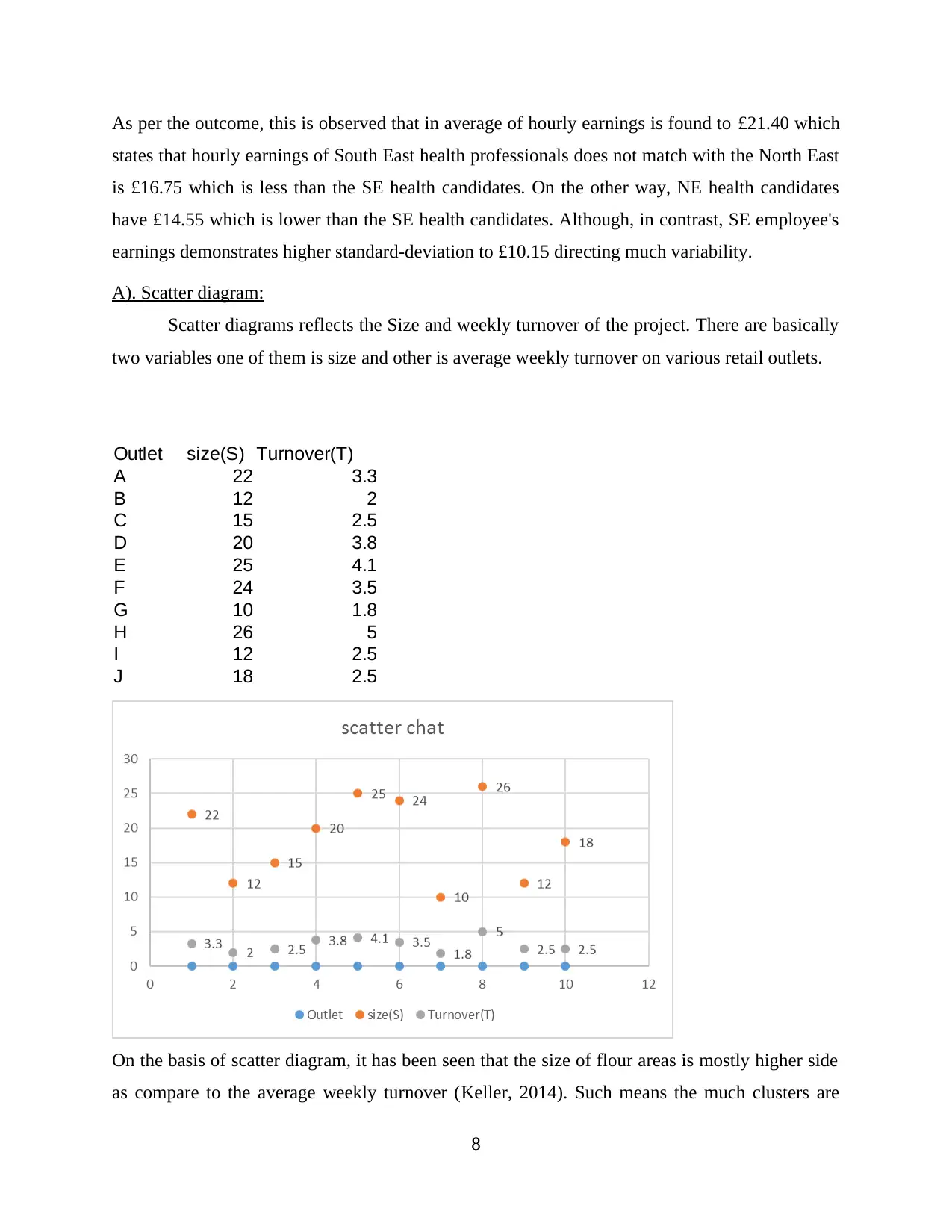
As per the outcome, this is observed that in average of hourly earnings is found to £21.40 which
states that hourly earnings of South East health professionals does not match with the North East
is £16.75 which is less than the SE health candidates. On the other way, NE health candidates
have £14.55 which is lower than the SE health candidates. Although, in contrast, SE employee's
earnings demonstrates higher standard-deviation to £10.15 directing much variability.
A). Scatter diagram:
Scatter diagrams reflects the Size and weekly turnover of the project. There are basically
two variables one of them is size and other is average weekly turnover on various retail outlets.
Outlet size(S) Turnover(T)
A 22 3.3
B 12 2
C 15 2.5
D 20 3.8
E 25 4.1
F 24 3.5
G 10 1.8
H 26 5
I 12 2.5
J 18 2.5
On the basis of scatter diagram, it has been seen that the size of flour areas is mostly higher side
as compare to the average weekly turnover (Keller, 2014). Such means the much clusters are
8
states that hourly earnings of South East health professionals does not match with the North East
is £16.75 which is less than the SE health candidates. On the other way, NE health candidates
have £14.55 which is lower than the SE health candidates. Although, in contrast, SE employee's
earnings demonstrates higher standard-deviation to £10.15 directing much variability.
A). Scatter diagram:
Scatter diagrams reflects the Size and weekly turnover of the project. There are basically
two variables one of them is size and other is average weekly turnover on various retail outlets.
Outlet size(S) Turnover(T)
A 22 3.3
B 12 2
C 15 2.5
D 20 3.8
E 25 4.1
F 24 3.5
G 10 1.8
H 26 5
I 12 2.5
J 18 2.5
On the basis of scatter diagram, it has been seen that the size of flour areas is mostly higher side
as compare to the average weekly turnover (Keller, 2014). Such means the much clusters are
8
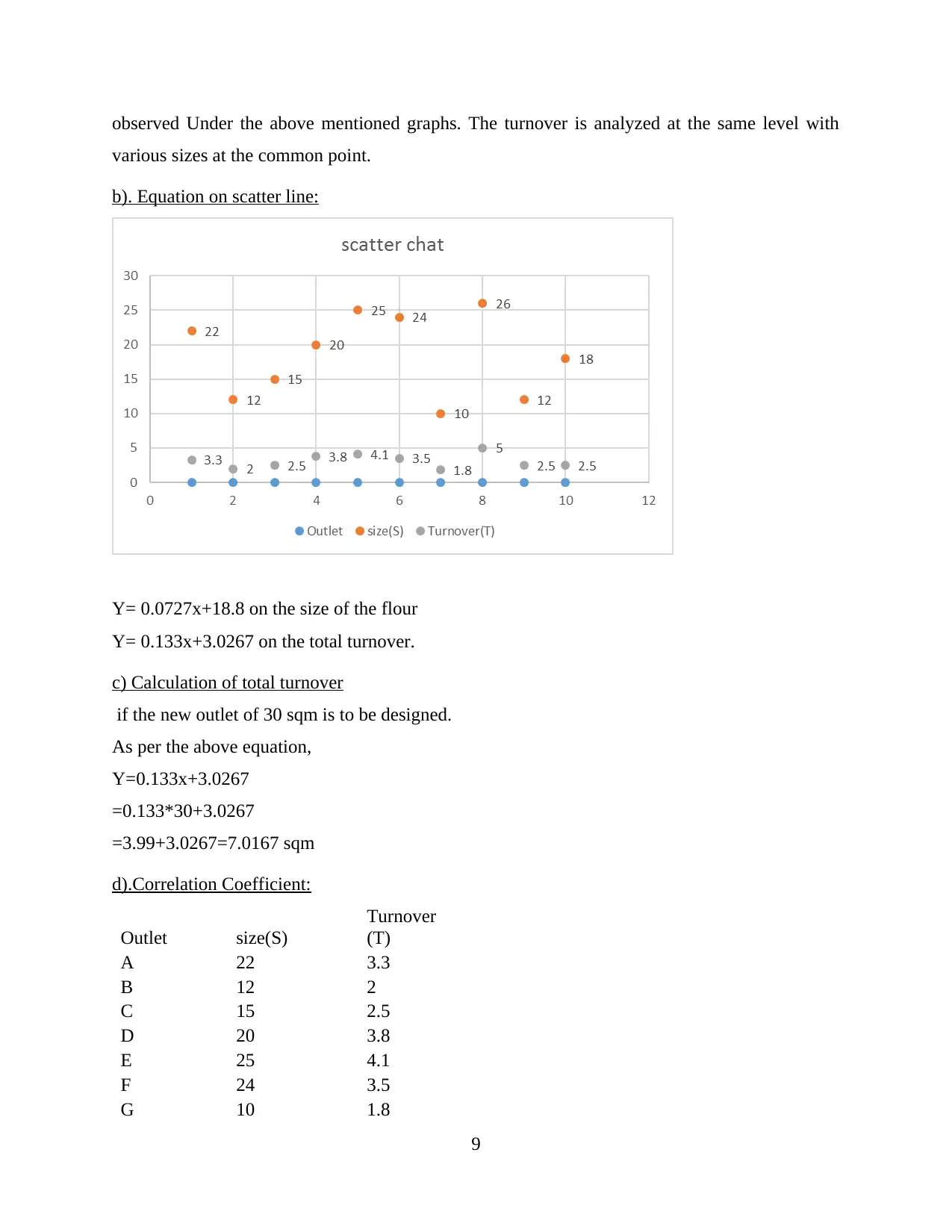
observed Under the above mentioned graphs. The turnover is analyzed at the same level with
various sizes at the common point.
b). Equation on scatter line:
Y= 0.0727x+18.8 on the size of the flour
Y= 0.133x+3.0267 on the total turnover.
c) Calculation of total turnover
if the new outlet of 30 sqm is to be designed.
As per the above equation,
Y=0.133x+3.0267
=0.133*30+3.0267
=3.99+3.0267=7.0167 sqm
d).Correlation Coefficient:
Outlet size(S)
Turnover
(T)
A 22 3.3
B 12 2
C 15 2.5
D 20 3.8
E 25 4.1
F 24 3.5
G 10 1.8
9
various sizes at the common point.
b). Equation on scatter line:
Y= 0.0727x+18.8 on the size of the flour
Y= 0.133x+3.0267 on the total turnover.
c) Calculation of total turnover
if the new outlet of 30 sqm is to be designed.
As per the above equation,
Y=0.133x+3.0267
=0.133*30+3.0267
=3.99+3.0267=7.0167 sqm
d).Correlation Coefficient:
Outlet size(S)
Turnover
(T)
A 22 3.3
B 12 2
C 15 2.5
D 20 3.8
E 25 4.1
F 24 3.5
G 10 1.8
9
You're viewing a preview
Unlock full access by subscribing today!
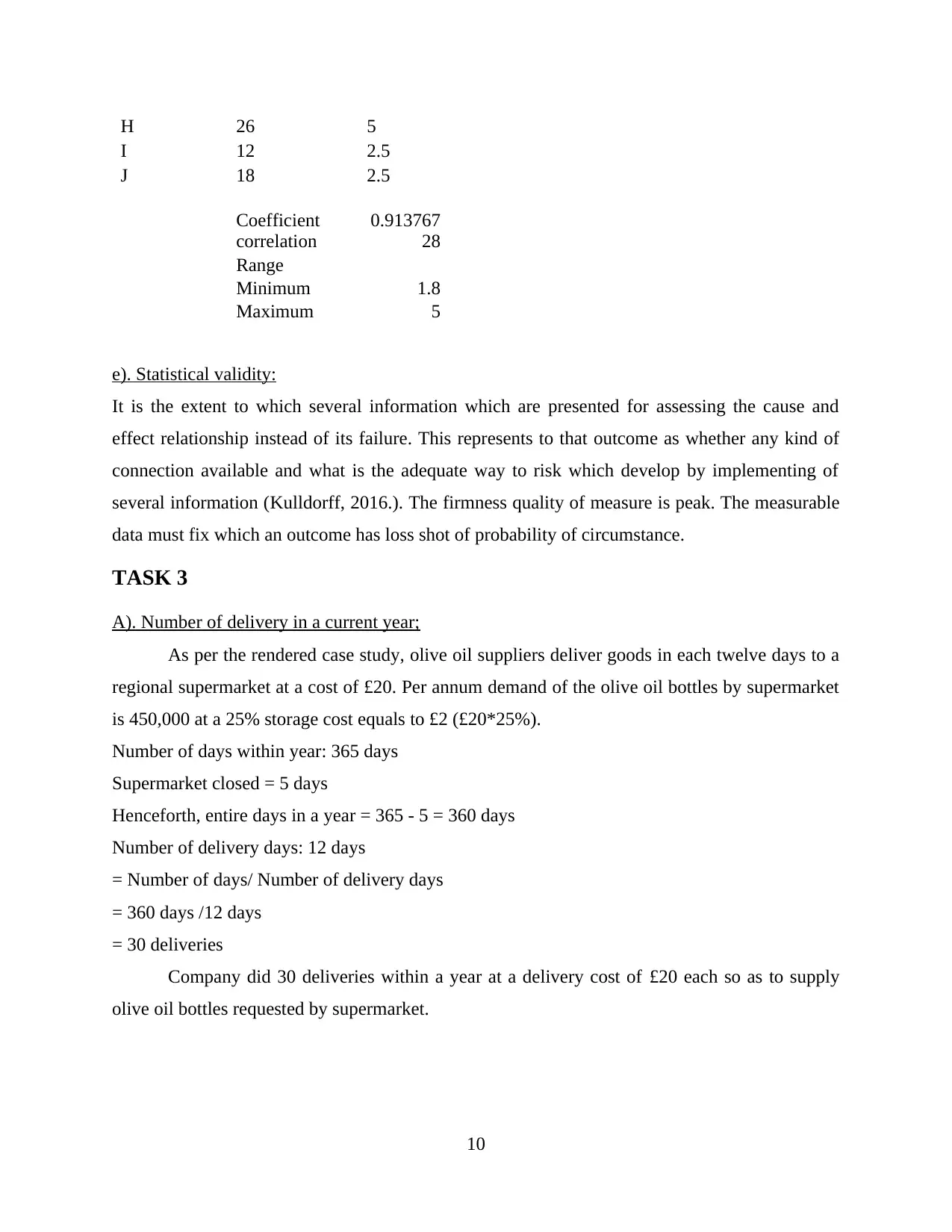
H 26 5
I 12 2.5
J 18 2.5
Coefficient
correlation
0.913767
28
Range
Minimum 1.8
Maximum 5
e). Statistical validity:
It is the extent to which several information which are presented for assessing the cause and
effect relationship instead of its failure. This represents to that outcome as whether any kind of
connection available and what is the adequate way to risk which develop by implementing of
several information (Kulldorff, 2016.). The firmness quality of measure is peak. The measurable
data must fix which an outcome has loss shot of probability of circumstance.
TASK 3
A). Number of delivery in a current year;
As per the rendered case study, olive oil suppliers deliver goods in each twelve days to a
regional supermarket at a cost of £20. Per annum demand of the olive oil bottles by supermarket
is 450,000 at a 25% storage cost equals to £2 (£20*25%).
Number of days within year: 365 days
Supermarket closed = 5 days
Henceforth, entire days in a year = 365 - 5 = 360 days
Number of delivery days: 12 days
= Number of days/ Number of delivery days
= 360 days /12 days
= 30 deliveries
Company did 30 deliveries within a year at a delivery cost of £20 each so as to supply
olive oil bottles requested by supermarket.
10
I 12 2.5
J 18 2.5
Coefficient
correlation
0.913767
28
Range
Minimum 1.8
Maximum 5
e). Statistical validity:
It is the extent to which several information which are presented for assessing the cause and
effect relationship instead of its failure. This represents to that outcome as whether any kind of
connection available and what is the adequate way to risk which develop by implementing of
several information (Kulldorff, 2016.). The firmness quality of measure is peak. The measurable
data must fix which an outcome has loss shot of probability of circumstance.
TASK 3
A). Number of delivery in a current year;
As per the rendered case study, olive oil suppliers deliver goods in each twelve days to a
regional supermarket at a cost of £20. Per annum demand of the olive oil bottles by supermarket
is 450,000 at a 25% storage cost equals to £2 (£20*25%).
Number of days within year: 365 days
Supermarket closed = 5 days
Henceforth, entire days in a year = 365 - 5 = 360 days
Number of delivery days: 12 days
= Number of days/ Number of delivery days
= 360 days /12 days
= 30 deliveries
Company did 30 deliveries within a year at a delivery cost of £20 each so as to supply
olive oil bottles requested by supermarket.
10
Paraphrase This Document
Need a fresh take? Get an instant paraphrase of this document with our AI Paraphraser

B. Number of bottles delivery delivered with each delivery:
Market Demand of olive oil bottles: 450000
Number of deliveries: 30
= 450,000/30
= 15,000 bottles are delivered with each delivery.
In each order, 15000 bottles would be delivered. Henceforth, management takes the
responsibility to place such a huge number of bottles in a one order which aid them in forming
their operations flourishing in nature (Menglu, 2013).
C. Calculation of EOQ:
EOQ determines quantity or number of units which firm requires to supply in each order in order
to retain their total cost at least level.
EOQ=√2AO/ C
Here, A is the annual demand
O= Ordering costs per order
C= carrying cost per unit
hence, EOQ is:
=√(2*450,000 units *£20)/£2=3000 bottles.
D. Comparison between current operating model and economic order quantity:
Particulars Formula Values
Current ordering units= 15000
Total Ordering costs Number of order* per order
cost
(450,000/15,000) *£20=30
orders* £20/order= £600
Total carrying costs Average inventory * holding
cost per unit
(0 + 15,000)/2 * £2/unit
= 7,500 units * £2/unit
= £15,000
11
Market Demand of olive oil bottles: 450000
Number of deliveries: 30
= 450,000/30
= 15,000 bottles are delivered with each delivery.
In each order, 15000 bottles would be delivered. Henceforth, management takes the
responsibility to place such a huge number of bottles in a one order which aid them in forming
their operations flourishing in nature (Menglu, 2013).
C. Calculation of EOQ:
EOQ determines quantity or number of units which firm requires to supply in each order in order
to retain their total cost at least level.
EOQ=√2AO/ C
Here, A is the annual demand
O= Ordering costs per order
C= carrying cost per unit
hence, EOQ is:
=√(2*450,000 units *£20)/£2=3000 bottles.
D. Comparison between current operating model and economic order quantity:
Particulars Formula Values
Current ordering units= 15000
Total Ordering costs Number of order* per order
cost
(450,000/15,000) *£20=30
orders* £20/order= £600
Total carrying costs Average inventory * holding
cost per unit
(0 + 15,000)/2 * £2/unit
= 7,500 units * £2/unit
= £15,000
11
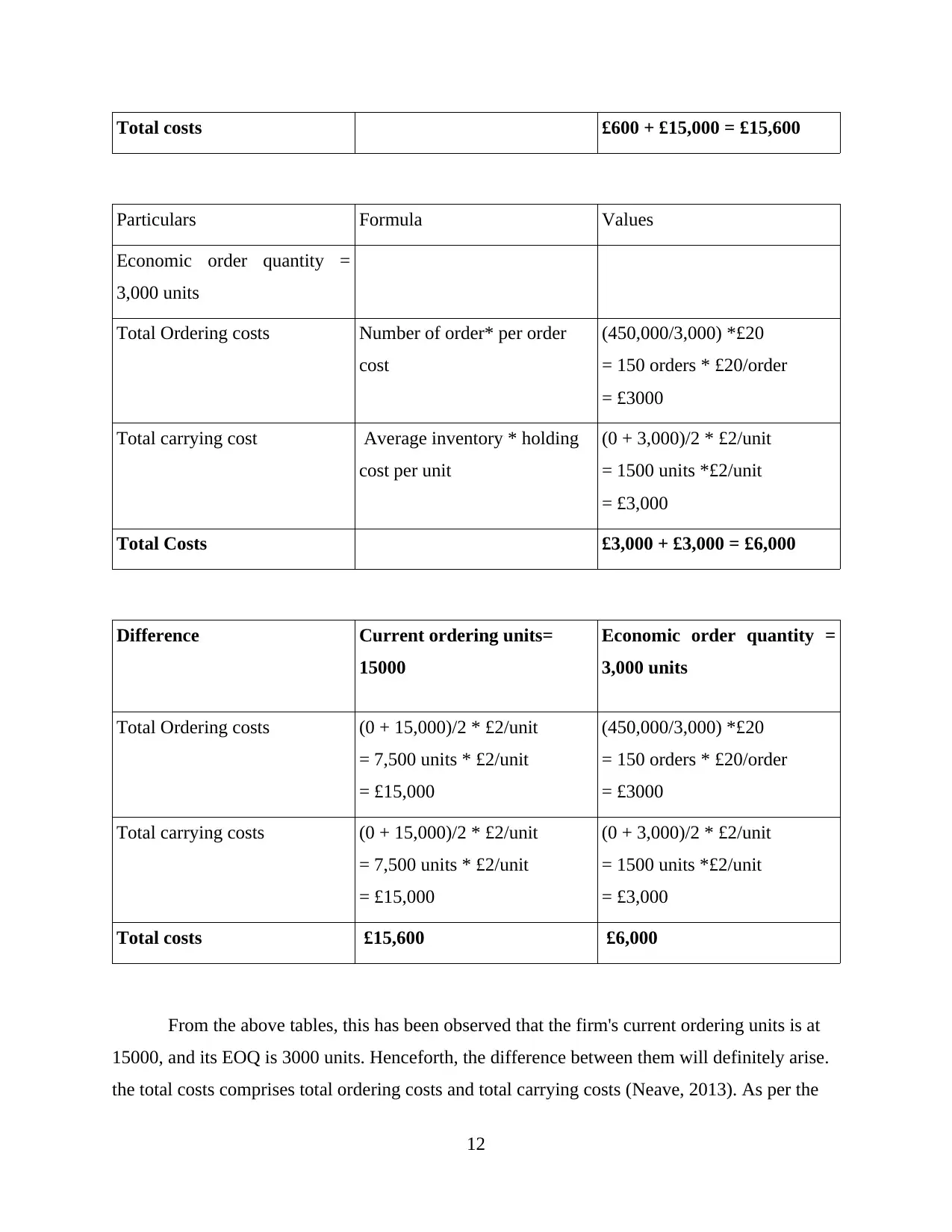
Total costs £600 + £15,000 = £15,600
Particulars Formula Values
Economic order quantity =
3,000 units
Total Ordering costs Number of order* per order
cost
(450,000/3,000) *£20
= 150 orders * £20/order
= £3000
Total carrying cost Average inventory * holding
cost per unit
(0 + 3,000)/2 * £2/unit
= 1500 units *£2/unit
= £3,000
Total Costs £3,000 + £3,000 = £6,000
Difference Current ordering units=
15000
Economic order quantity =
3,000 units
Total Ordering costs (0 + 15,000)/2 * £2/unit
= 7,500 units * £2/unit
= £15,000
(450,000/3,000) *£20
= 150 orders * £20/order
= £3000
Total carrying costs (0 + 15,000)/2 * £2/unit
= 7,500 units * £2/unit
= £15,000
(0 + 3,000)/2 * £2/unit
= 1500 units *£2/unit
= £3,000
Total costs £15,600 £6,000
From the above tables, this has been observed that the firm's current ordering units is at
15000, and its EOQ is 3000 units. Henceforth, the difference between them will definitely arise.
the total costs comprises total ordering costs and total carrying costs (Neave, 2013). As per the
12
Particulars Formula Values
Economic order quantity =
3,000 units
Total Ordering costs Number of order* per order
cost
(450,000/3,000) *£20
= 150 orders * £20/order
= £3000
Total carrying cost Average inventory * holding
cost per unit
(0 + 3,000)/2 * £2/unit
= 1500 units *£2/unit
= £3,000
Total Costs £3,000 + £3,000 = £6,000
Difference Current ordering units=
15000
Economic order quantity =
3,000 units
Total Ordering costs (0 + 15,000)/2 * £2/unit
= 7,500 units * £2/unit
= £15,000
(450,000/3,000) *£20
= 150 orders * £20/order
= £3000
Total carrying costs (0 + 15,000)/2 * £2/unit
= 7,500 units * £2/unit
= £15,000
(0 + 3,000)/2 * £2/unit
= 1500 units *£2/unit
= £3,000
Total costs £15,600 £6,000
From the above tables, this has been observed that the firm's current ordering units is at
15000, and its EOQ is 3000 units. Henceforth, the difference between them will definitely arise.
the total costs comprises total ordering costs and total carrying costs (Neave, 2013). As per the
12
You're viewing a preview
Unlock full access by subscribing today!
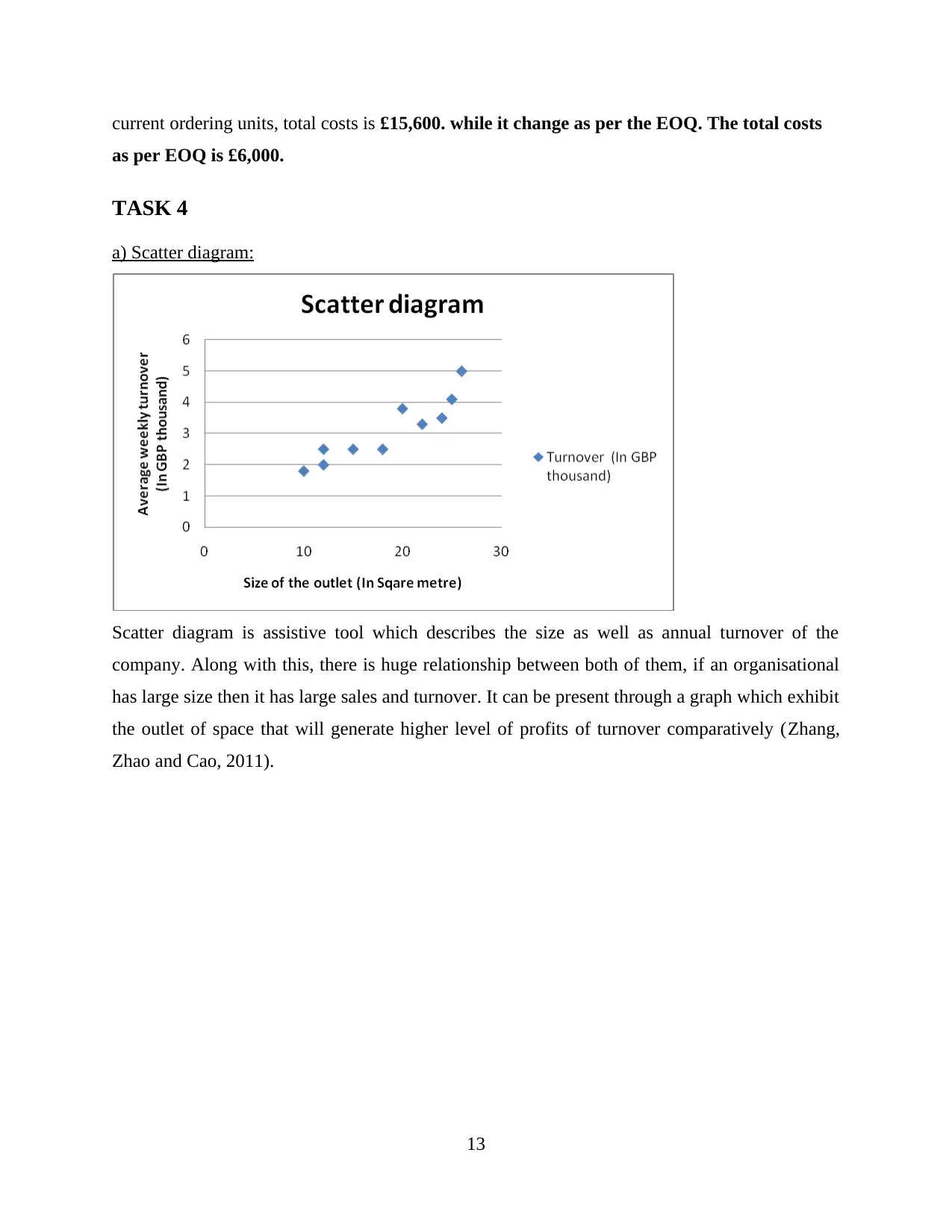
current ordering units, total costs is £15,600. while it change as per the EOQ. The total costs
as per EOQ is £6,000.
TASK 4
a) Scatter diagram:
Scatter diagram is assistive tool which describes the size as well as annual turnover of the
company. Along with this, there is huge relationship between both of them, if an organisational
has large size then it has large sales and turnover. It can be present through a graph which exhibit
the outlet of space that will generate higher level of profits of turnover comparatively (Zhang,
Zhao and Cao, 2011).
13
as per EOQ is £6,000.
TASK 4
a) Scatter diagram:
Scatter diagram is assistive tool which describes the size as well as annual turnover of the
company. Along with this, there is huge relationship between both of them, if an organisational
has large size then it has large sales and turnover. It can be present through a graph which exhibit
the outlet of space that will generate higher level of profits of turnover comparatively (Zhang,
Zhao and Cao, 2011).
13
Paraphrase This Document
Need a fresh take? Get an instant paraphrase of this document with our AI Paraphraser
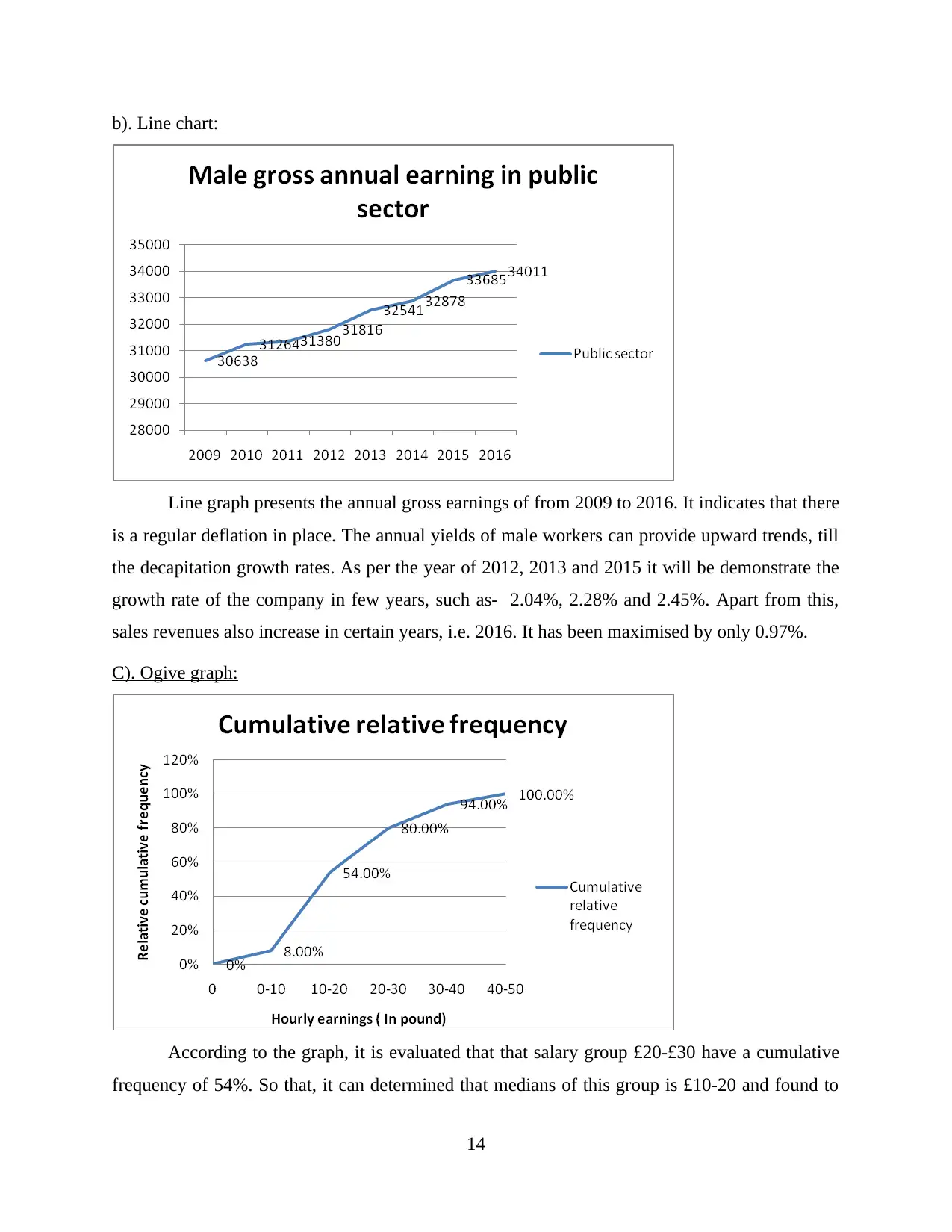
b). Line chart:
Line graph presents the annual gross earnings of from 2009 to 2016. It indicates that there
is a regular deflation in place. The annual yields of male workers can provide upward trends, till
the decapitation growth rates. As per the year of 2012, 2013 and 2015 it will be demonstrate the
growth rate of the company in few years, such as- 2.04%, 2.28% and 2.45%. Apart from this,
sales revenues also increase in certain years, i.e. 2016. It has been maximised by only 0.97%.
C). Ogive graph:
According to the graph, it is evaluated that that salary group £20-£30 have a cumulative
frequency of 54%. So that, it can determined that medians of this group is £10-20 and found to
14
Line graph presents the annual gross earnings of from 2009 to 2016. It indicates that there
is a regular deflation in place. The annual yields of male workers can provide upward trends, till
the decapitation growth rates. As per the year of 2012, 2013 and 2015 it will be demonstrate the
growth rate of the company in few years, such as- 2.04%, 2.28% and 2.45%. Apart from this,
sales revenues also increase in certain years, i.e. 2016. It has been maximised by only 0.97%.
C). Ogive graph:
According to the graph, it is evaluated that that salary group £20-£30 have a cumulative
frequency of 54%. So that, it can determined that medians of this group is £10-20 and found to
14
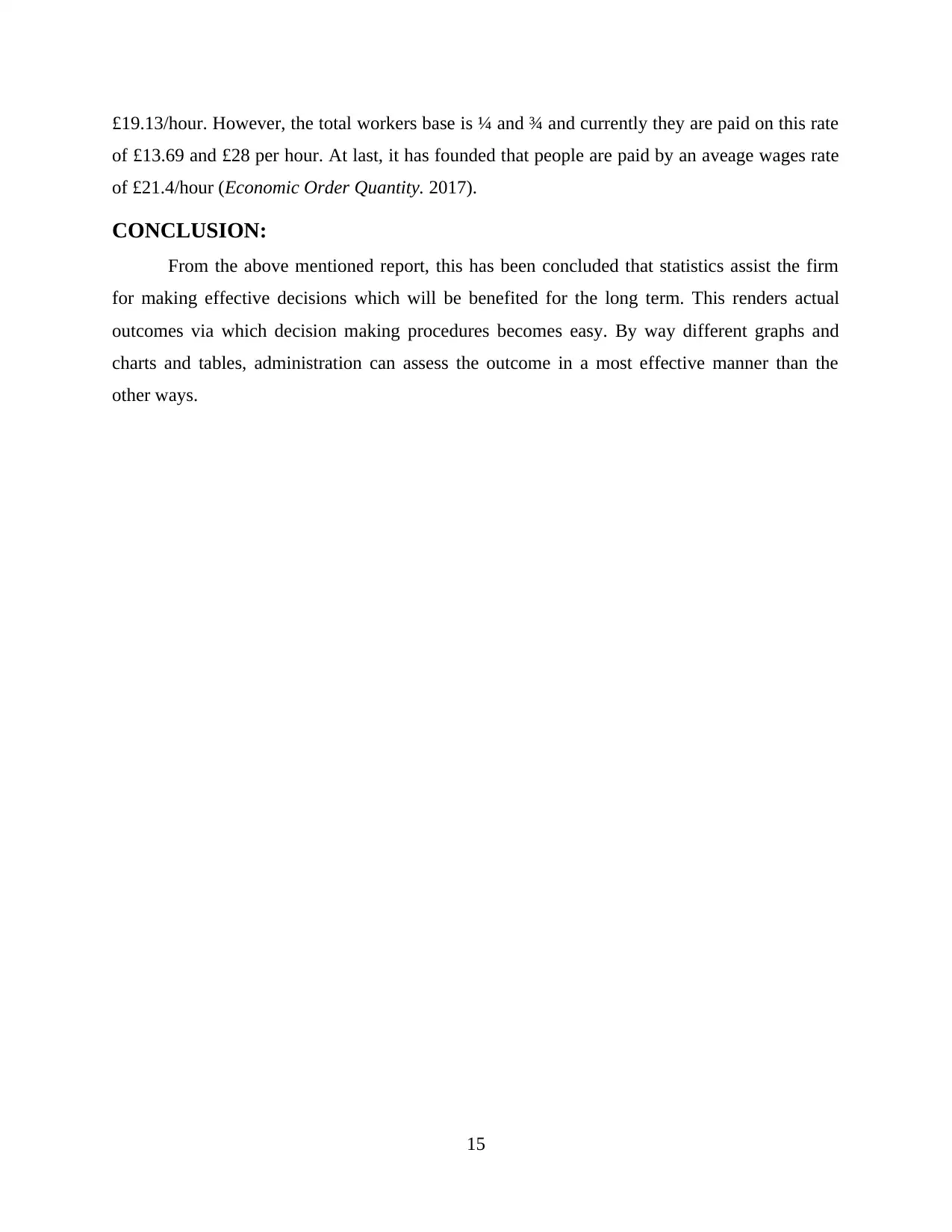
£19.13/hour. However, the total workers base is ¼ and ¾ and currently they are paid on this rate
of £13.69 and £28 per hour. At last, it has founded that people are paid by an aveage wages rate
of £21.4/hour (Economic Order Quantity. 2017).
CONCLUSION:
From the above mentioned report, this has been concluded that statistics assist the firm
for making effective decisions which will be benefited for the long term. This renders actual
outcomes via which decision making procedures becomes easy. By way different graphs and
charts and tables, administration can assess the outcome in a most effective manner than the
other ways.
15
of £13.69 and £28 per hour. At last, it has founded that people are paid by an aveage wages rate
of £21.4/hour (Economic Order Quantity. 2017).
CONCLUSION:
From the above mentioned report, this has been concluded that statistics assist the firm
for making effective decisions which will be benefited for the long term. This renders actual
outcomes via which decision making procedures becomes easy. By way different graphs and
charts and tables, administration can assess the outcome in a most effective manner than the
other ways.
15
You're viewing a preview
Unlock full access by subscribing today!
1 out of 18
Related Documents
Your All-in-One AI-Powered Toolkit for Academic Success.
+13062052269
info@desklib.com
Available 24*7 on WhatsApp / Email
![[object Object]](/_next/static/media/star-bottom.7253800d.svg)
Unlock your academic potential
© 2024 | Zucol Services PVT LTD | All rights reserved.





